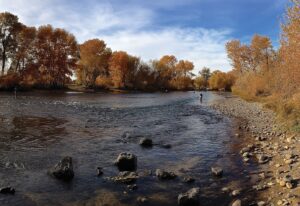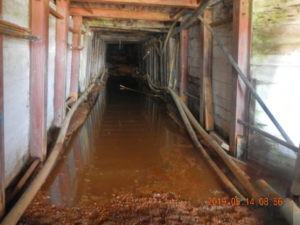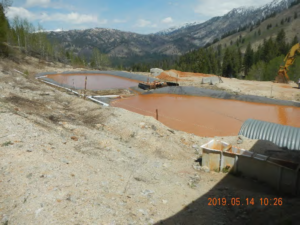The Boise River is the lifeblood of the Treasure Valley. From the more than 100,000 people that beat the heat with a float down the river in the summer, to the anglers that fish in it, to the people that watch for wildlife among its banks – the Boise River offers something for everyone. Protecting the Boise River is in everyone’s best interest, but the river has faced its share of threats in the past and continues to today.

Some may recall that the Boise River was once threatened by a proposal from Atlanta Gold mining company to construct an open-pit cyanide heap leach mine in the early 2000s. The mine proposal was withdrawn in part because the Idaho Conservation League found that Atlanta Gold failed to control arsenic coming out of a mine tunnel that it managed. Although Atlanta Gold agreed to construct a water treatment facility, toxic levels of arsenic continued to reach the Boise River headwaters every spring – threatening both people and wildlife that relied on the river. A federal court levied a $2 million fine against Atlanta Gold and ordered that arsenic levels must be kept within permitted levels.
While this legal win did lead to temporary improvements, Atlanta Gold’s arsenic problem has gotten worse – much worse – recently.
The source for the arsenic is a mining tunnel located deep in the headwaters of the Middle Fork of the Boise River near the small town of Atlanta. The tunnel, known as the 900 Level Adit (an adit is a horizontal underground tunnel where mineral rich ore is excavated from), sits about one mile southeast of the town.

Oftentimes, water seeping out of mining adits can be heavily polluted with heavy metals like lead, arsenic, and chromium. That’s because when mining tunnels cut through mountains, heavy metals that were previously bound in the rock can be mobilized and transported into groundwater that passes through the fractured rock. Eventually, this contaminated groundwater can flow out of the adit opening, often into nearby streams and rivers.
Instead of meeting clean water standards as required, the discharge from the adit has recently become Idaho’s most illicit site of toxic wastewater discharge due to alarming levels of arsenic. The location of the site at the headwaters of the Boise River is also troubling. Water from the adit drains into nearby Montezuma Creek, which then flows into the Middle Fork of the Boise River, passes through Arrowrock and Lucky Peak Reservoirs, and winds through downtown Boise.
Atlanta Gold’s history in Idaho
Atlanta Gold obtained a permit from the Forest Service to modify the historic mining tunnel in the 1990s, and the water flows and arsenic levels subsequently changed. After the Idaho Conservation League raised concerns about these unpermitted arsenic discharges, the company agreed to construct a pilot water treatment facility to reduce the arsenic levels and meet Clean Water Act standards before discharging the water into Montezuma Creek.
Atlanta Gold has struggled to meet those minimum requirements, particularly when it comes to springtime water quality discharge – polluting Montezuma Creek with arsenic. This didn’t go unnoticed. In both 2012 and 2017, ICL successfully sued Atlanta Gold under citizen suit provisions of the Clean Water Act for 2,567 wastewater violations. This resulted in over $2 million worth of government penalties for Atlanta Gold, as well as court orders for them to improve their wastewater treatment operations.

What’s happening now
Since 2011, Atlanta Gold has discharged approximately 1,560 pounds of arsenic – violating their permit, and polluting the water that hundreds of thousands of Idahoans rely on. While arsenic levels regularly exceeded permitted levels during high spring flows from the adit for many years, exceedances are now much higher and occurring year-round. Since May of 2020, arsenic concentrations have spiked further, with monthly averages as high as 125 times their permitted limits. In 2020 and 2021, the Environmental Protection Agency’s (EPA) ECHO Water Pollutant Loading Search tool showed Atlanta Gold as the most toxic illicit wastewater discharger in Idaho – with their discharge of the equivalent of 241 pounds of arsenic.
What can be done
The Boise River is a precious resource – and more must be done to protect it. The residents of Atlanta directly adjacent to Atlanta Gold, as well as the near 800,000 people downstream in the greater Boise metropolitan area, all rely on the Boise River watershed for drinking water, irrigation, and recreation. More must be done to end this large-scale pollution of Idaho’s water, especially in a region that affects so many of Idaho’s citizens.
The Idaho Conservation League is engaging with both the U.S. Forest Service and the Idaho Department of Environmental Quality (IDEQ) to see what more can be done to protect the water that so many of us rely on. As the surface land manager for which the 900 Level Adit sits on, the U.S. Forest Service has an obligation to make sure that water is protected from mine pollution. As the regulatory agency responsible for issuing and enforcing discharge permits, IDEQ has a duty to ensure Atlanta Gold is complying with the terms of its permit and not discharging illegal amounts of arsenic. Atlanta Gold is no longer a highly visible company in Idaho and it is unclear what resources they can bring to bear. They did leave the Forest Service with a bond of approximately $40,000 to restore the site, but that amount will not cover long-term water treatment costs.
If you care about the Boise River and would like to help support ICL in this effort, sign up for ICL’s Public Lands emails here. If you have any specific questions or comments on Atlanta Gold’s 900 Level Adit operations, contact ICL’s Conservation Associate Will Tiedemann.

